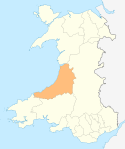Pontrhydfendigaid
The ruins of the Cistercian Strata Florida Abbey are 1 mile south-east of the village. The abbey was founded 1164; the poet Dafydd ap Gwilym is traditionally said to be buried there and Llywelyn the Great held a council there. The station at Strata Florida was positioned to serve the village. The hillfort of Pen y Bannau is 1 km east of the village.
The village is home to an annual eisteddfod, the Eisteddfod Pantyfedwen, or colloquially the "Steddfod Bont". Concerts and other events are also held in the modern multi-purpose Pavilion here. A Celtic Music Society is based at the village's Black Lion Hotel.
The village was the birthplace and home of Caradog Jones, the first Welshman to reach the summit of Mount Everest.
It is in the Community of Ystrad Fflur.
The village takes its name from an old ford (rhyd) across the Teifi and a bridge (pont) that was later built there. It is on the B4343 road between Tregaron to the south and Pontarfynach to the north, around 13 miles (21 km) to the south-east of Aberystwyth.
The abbey was an important centre of learning, and it is believed that one of the earliest versions of the Brut y Tywysogion was made there.
It is believed that the TV programme C'mon Midffild! is based on the village football club.
Pontrhydfendigaid in fiction
In the novel The Discovery of Heaven by Dutch author Harry Mulisch, the village is the place where the characters Mr and Mrs Spiers spend their holidays.
The Beast of Bont
The Beast of Bont is the name given to a big cat said to roam the area centred on Pontrhydfendigaid. (Y Bont is the local abbreviation and colloquial name for Pontrhydfendigaid.) It was blamed for the death of 12 sheep in June 1981. After a number of livestock attacks in the mid-1990s, Ministry of Agriculture veterinarians inspected a sheep carcass "and declared that the killer was a great deal more powerful than a fox or dog". The Dyfed-Powys police then searched the area, but failed to find the animal.
In the spring of 2012, Mark Davey and his partner Annette came across a "sickening" scene: two large groups of slaughtered sheep, about two miles apart, in the hills near Devil's Bridge. In a statement to local newspapers, he reported that "something had quite clearly attacked them because they looked like they had been ripped apart" and that "to kill so many sheep in such a small area it had to be quite a strong animal".
References
- ^ Walesdirectory.co.uk - Pontrhydfendigaid
- ^ "Custom report - Nomis - Official Labour Market Statistics".
- ^ "Clwb pêl-droed yn dathlu 60". BBC Cymru Newyddion (in Welsh). 11 June 2007. Retrieved 5 December 2019.
- ^ Sheldrick, Giles (16 May 2012). "20 Sheep Found Butchered by 'Beast of Bont". The Daily Express. Retrieved 21 February 2013.
- ^ Furness, Hannah (15 May 2012). "'Beast of Bont' Returns as 20 Sheep Found Massacred". The Telegraph. Archived from the original on 17 May 2012. Retrieved 21 February 2013.
- ^ Morgan, Sion (11 May 2012). "Video: Is this the clearest evidence yet that a big cat is roaming Welsh hills?". http://www.walesonline.co.uk. Retrieved 21 February 2013.
{{cite news}}: External link in|newspaper=
